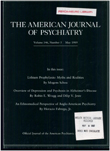Somatization disorder in a community population
Abstract
The data recently collected in the Piedmont region of North Carolina as part of the National Institute of Mental Health Epidemiologic Catchment Area Program were used to examine somatization disorder in a community population. The authors found an adjusted prevalence of 0.38% for somatization disorder diagnosed according to the Diagnostic Interview Schedule and DSM-III. Respondents with somatization disorder demonstrated demographic characteristics (female, unmarried, nonwhite, from a rural area, less educated) that are consistent with findings from past clinical and epidemiologic studies of somatization disorder. The adjusted prevalence is higher than that of other Epidemiologic Catchment Area sites, and possible explanations for this findings are discussed.
Access content
To read the fulltext, please use one of the options below to sign in or purchase access.- Personal login
- Institutional Login
- Sign in via OpenAthens
- Register for access
-
Please login/register if you wish to pair your device and check access availability.
Not a subscriber?
PsychiatryOnline subscription options offer access to the DSM-5 library, books, journals, CME, and patient resources. This all-in-one virtual library provides psychiatrists and mental health professionals with key resources for diagnosis, treatment, research, and professional development.
Need more help? PsychiatryOnline Customer Service may be reached by emailing [email protected] or by calling 800-368-5777 (in the U.S.) or 703-907-7322 (outside the U.S.).



